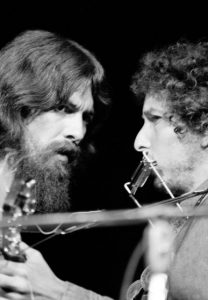This article is part of a unique series which reviews the artwork on Dylan’s albums. A full index can be found here. The most recent articles are
by Patrick Roefflaer
- Bob Dylan’s Greatest Hits Volume II
- Released: November 17, 1971
- Photographer front: Barry Feinstein (1971)
- Photographer backside: ? (Apple Film)
- Art-director: ?
 On Sunday, August 1, 1971, two benefit concerts will take place at New York’s Madison Square Garden to raise money for the people of Bangladesh (formerly known as East Pakistan). As a result of civil war and persistent severe weather, the living conditions for the many refugees are harrowing. The first benefit in music history is an initiative of George Harrison. Unsure if enough people are interested in him alone, the ex-Beatle enlists the help of friendly musicians. He even manages to get both Eric Clapton and Bob Dylan out of their isolation.
On Sunday, August 1, 1971, two benefit concerts will take place at New York’s Madison Square Garden to raise money for the people of Bangladesh (formerly known as East Pakistan). As a result of civil war and persistent severe weather, the living conditions for the many refugees are harrowing. The first benefit in music history is an initiative of George Harrison. Unsure if enough people are interested in him alone, the ex-Beatle enlists the help of friendly musicians. He even manages to get both Eric Clapton and Bob Dylan out of their isolation.
It has been five years since Dylan last toured and his appearance is eagerly anticipated. The five songs he performs are the highlight of the show and the reactions of press and public are unanimously positive. His record company, Columbia Records, is very happy with the renewed interest in their artist and wants to cash in on this. As Bob has no new material, it is decided that the best option is a compilation.
Naturally there has to be a photo from Bob at the concert on the front cover. So Columbia’s art director has to contact the official photographers for the concerts: Camouflage Productions.
That creative team consists of photographer Barry Feinstein and designer Tom Wilkes who were previously responsible for the cover of Harrison’s album All Things Must Pass and of course also for the packaging of The Concert for Bangla Desh (sic).
 Dylan chooses two photos by his buddy Feinstein (see The Times They Are A-Changin’). On the first, taken during rehearsal the day before the concert, Bob Dylan and George Harrison are seen from the back, against a blue background and lit from the left by a white spotlight. Harrison says something and Dylan listens intently.
Dylan chooses two photos by his buddy Feinstein (see The Times They Are A-Changin’). On the first, taken during rehearsal the day before the concert, Bob Dylan and George Harrison are seen from the back, against a blue background and lit from the left by a white spotlight. Harrison says something and Dylan listens intently.
On the second, Bob’s face is on the left side of the photo, blowing his harmonica while a large number of microphones are on the right side. Both photos are landscape (twice as wide as high) and therefore excellent for a gatefold cover.
However, on both photographs, Dylan head is on the left side of the photo, so his head would end up on the back side of the cover. Mirroring would mess up the effect, because then Dylan would look to the left. (The reading direction in the Western world is from left to right, so a movement to the left is perceived as slowing down – decline, while a movement to the right indicates progress – forward-looking. If you would like to know more this video explains in detail why left to right, and right to left, matters).
The (unknown) designer solves the problem by cutting off Harrison and further enlarging Dylan’s head.
Striking is the resemblance of both photos with those on the cover of Bob Dylan’s Greatest Hits from 1967. On the front cover of that compilation there’s a portrait of Dylan in profile, looking to the right, with blue as the main color.
This is to the amazement of the photographer of that original photo, Rowland Scherman, who said, “I heard that Dylan didn’t like my photo [at the time], and then he chooses one that looks very similar. I said to him, ‘You little bastard.’ He looked embarrassed and turned around. He knew well enough that he was wrong the first time because the image captured Dylan so well in the sixties, with his hair, his harmonica and that halo.”


The portrait of Dylan used for the reverse side of the compilation is not really a photo, but a still image from the Apple film The Concert For Bangla Desh. Because Dylan was hesitant to give permission to use footage of him in the film, Harrison’s manager Alan Klein invited him to a private screening at the Ziegfeld Theater in Manhattan. He possibly selected that image then. Note the guitar strap that rests on the wrong shoulder, this image is also printed mirrored, so that Dylan is also looking to the right.
Because there was already a Bob Dylan’s Greatest Hits Vol. 2, released in Germany and the Netherlands (and later the UK), the new compilation gets a Roman numeral in the title: Vol. II.
To avoid further confusion, the cover will be given a new look in the Netherlands and a different name.
In England it is called More Bob Dylan Greatest Hits and in Italy: Un Poeta Un Artista.




